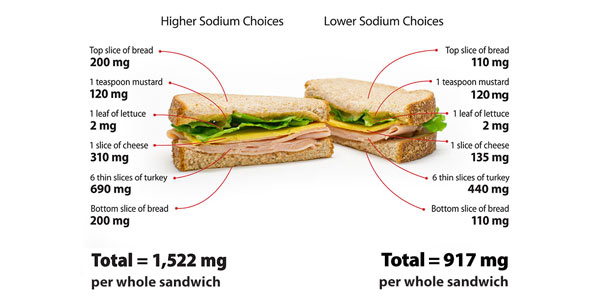Key points
- Eating too much sodium can increase blood pressure and the risk of heart disease and stroke.
- Most sodium in our diets comes from packaged and restaurant food, not the salt shaker.
- You can reduce sodium intake by following the tips below at the grocery store, at home, and in restaurants.

Why it's important
Eating too much sodium can increase blood pressure and the risk for heart disease and stroke. Together, heart disease and stroke kill more Americans each year than any other cause.
Even foods that may not taste salty can be major sources of sodium. Foods with only moderate amounts of sodium, such as bread, can be major sources of sodium because they’re eaten so frequently.

At the grocery store
- Buy fresh, frozen, or canned vegetables with no salt or sauce added.
- Choose packaged foods labeled "low sodium," "reduced sodium," or "no salt added" when available.
- Compare the amount of sodium in different products by reading Nutrition Facts labels. Check the amount of sodium per serving and the number of servings per container. Choose the options with the lowest amounts of sodium.
- When possible, purchase fresh poultry, fish, pork, and lean meat, rather than cured, salted, smoked, and other processed meats.
- For fresh items, check to see whether saline or salt solution has been added—if so, choose another brand.
- Ask your grocer if they have a low sodium shopping list available.
Tip
At home
- When cooking, replace or reduce the amount of salt you use. Alternatives could be garlic, citrus juice, salt-free seasonings, or spices.
- Prepare rice, pasta, beans, and meats from their most basic forms (dry and fresh) when possible.
- Eat more fruits and vegetables.
- Limit sauces, mixes, and instant products, including flavored rice and ready-made pasta.
At restaurants
- Ask for nutrition information before you order, and select a lower sodium meal.
- Ask that no salt be added to your meal.
- Order vegetables with no salt added or fruit as a side item.
- Split a meal with a friend or family member.
- Keep takeout and fast food to an occasional treat.
Choose a heart-healthy diet
The Dietary Approaches to Stop Hypertension (DASH) eating plan is a simple, heart-healthy diet that can help prevent or lower high blood pressure. The DASH diet is low in sodium, cholesterol, and saturated and total fats. The diet is high in fruits and vegetables, fiber, potassium, and low-fat dairy products.
